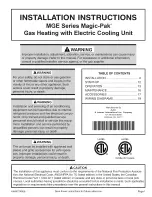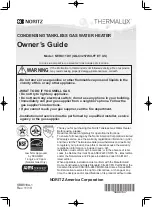
7
TNR-I&S-02
Direct Vent Terminal Location
Plan the vent system layout so that proper clearances are maintained
from plumbing and wiring. Before the vent is installed, determine the vent
pipe termination location as shown below in Figure 10.
Vent terminals must terminate at least 3 feet
(0.9 m)
above any forced air inlet
located within 10 feet
(3.1 m)
. This provision does not apply to:
1. The combustion air intake of a direct vent appliance or the circulating air
inlet and flue gas discharge of listed outdoor appliances.
2. The exhaust vent terminal must be installed with at least 12 inches
(30 cm)
clearance from any air opening into a building.
3. The bottom of the exhaust vent and combustion air intake terminals must
be located at least 12 inches
(30 cm)
above grade and above the anticipated
snow level.
4. Must be installed at least 3 feet
(0.9 m)
from any gas meter, gas valve or
other gas regulating equipment.Must be installed in a location where it will
not be blocked by snow.
5. The exhaust vent and combustion air intake terminals must be installed so
that the centerline distances are at least 18 inches
(45.7cm)
apart and the
exhaust vent terminal elbow extends 6 inches
(15.2 cm)
past the combustion
air intake terminal.
NOTICE
If 4 inch PVC or CPVC pipe is used, then a 4 inch PVC or CPVC screened
intake and exhaust 90° elbow is required.
Figure 10 Vent Terminal Location
EXCEPTIONS FOR INSTALLATIONS
The vent terminal must not terminate:
1. Directly above a paved sidewalk or paved driveway which is located
between two single-family dwellings and serves both dwellings;
2. Less than 7 feet
(2.1 m)
above a paved sidewalk or a paved
driveway located on public property;
3. Within 6 feet
(1.8 m)
of a mechanical air supply inlet to any
building;
4. Above a gas meter/regulator assembly within 3 feet
(0.9 m)
horizontally of the vertical centerline of the regulator;
5. Within 6 feet
(1.8m)
of any gas service regulator vent outlet;
6. Less than 1 foot
(30.5 cm)
above grade level;
7. Within 12 inches
(30.5 cm)
of a window or door, which can be
opened in any building, any non-mechanical air, supply inlet to any
building or the combustion air inlet of any other appliance;
8. Underneath a veranda, porch or deck, unless:
•
The veranda, porch or deck is fully open on a minimum of two
sides beneath the floor and
•
The distance between the top of the vent termination and the
underside of the veranda, porch or deck is greater than 1 foot
(30.5 cm)
.
The vent system must terminate so that proper clearances are maintained
as cited in local codes or the latest edition of the National Fuel Gas Code,
ANSI Z223.1.73.4e and 7.8a, b as follows:
1. Do not terminate the exhaust vent terminal over public area where
condensate or vapor can cause nuisance or hazard.
2. For direct vent, the venting system shall terminate at least 1 foot
below, 1 foot horizontally from or 1 foot above any door, window,
or gravity air inlet into building.






































